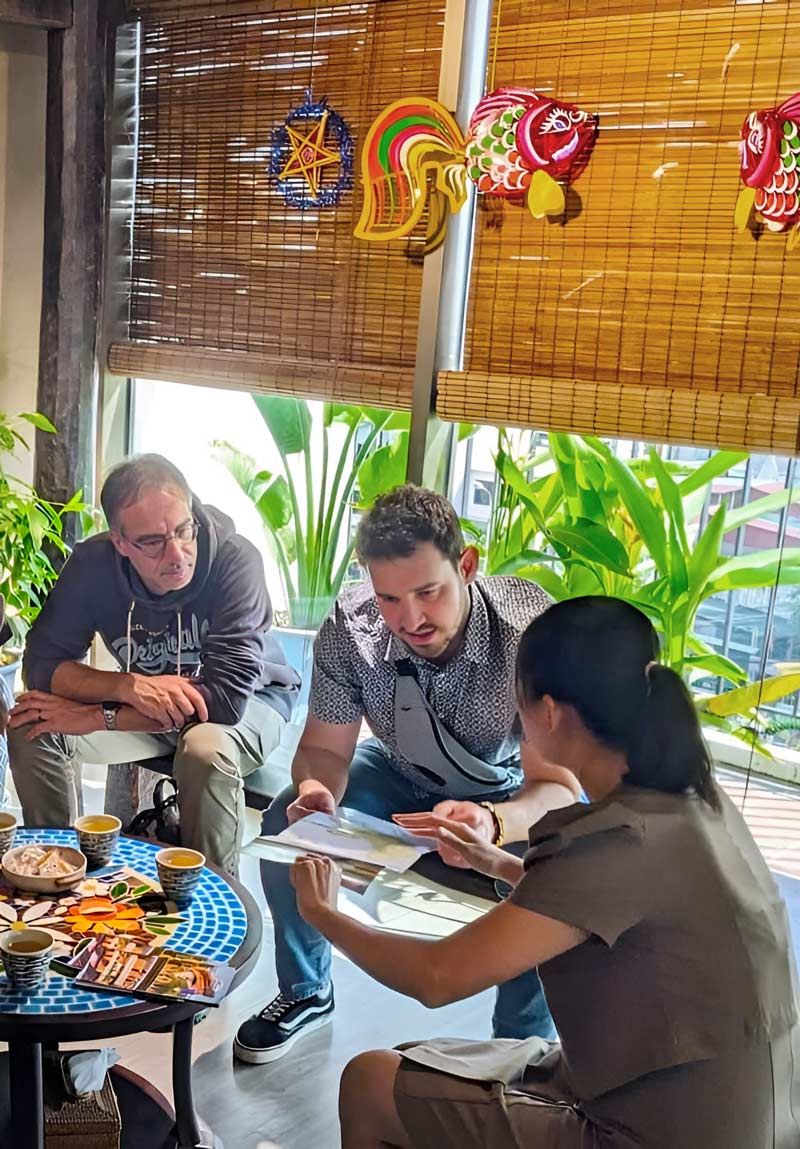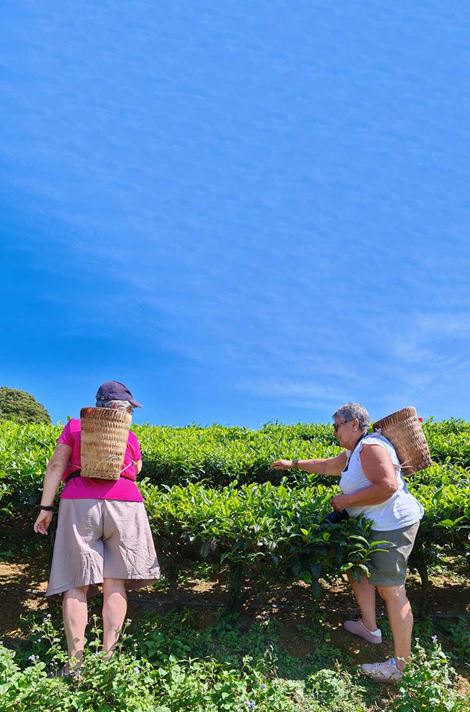Damnoen Saduak Guide: The World's Most Famous Floating Market
The Damnoen Saduak Floating Market in Ratchaburi province, just two hours from Bangkok, is one of the must-see experiences when staying in the capital and its surroundings. It first appeared in the nineteenth century, when King Rama IV ordered a canal to be dug to support transport and agricultural trade. Over time, the market grew from a local hub into one of Thailand’s most iconic attractions.
Today, even if some find it too touristy, its lively atmosphere, vibrant colors, and bustling energy still make it a memorable stop for first-time visitors to Bangkok. I had the chance to explore it myself and would like to share my impressions along with some practical tips to help you plan your visit.
- How to get to Damnoen Saduak Floating Market?
- Guide to boat trips in Damnoen Saduak
- Stops during the boat trip
- Practical Tips for Visiting Damnoen Saduak Floating Market
- Gastronomy: an unmissable experience at the floating market
- Damnoen Saduak Floating Market Reviews: Pros and Cons
- Negatives
- Quieter alternatives around Bangkok
- Our last words
How to get to Damnoen Saduak Floating Market?
The Damnoen Saduak Floating Market is about a 1.5 to 2-hour drive from Bangkok. Because traffic in the capital can be unpredictable, it’s best to plan your departure in advance and allow some extra time.
Here are the most common ways to get there:
- Bus, minivan, or group tour (affordable but less flexible).
- Taxi or private car (faster and more comfortable).
- Booking a car through your hotel (a safe choice that helps you avoid taxi scams).
If you want the easiest option, a day trip from Bangkok is both practical and secure, while minimizing the risk of scams.
Guide to boat trips in Damnoen Saduak
The highlight of Damnoen Saduak Floating Market is definitely the boat ride along the canal. You have two main choices:
- Motorboat: fast and able to overtake others, but often a bit disappointing. Most trips feel like a quick crossing with just a few short stops before heading back to the dock, without really passing through the lively merchant area.
- Rowing boat: slower, eco-friendly, and much more charming. You can chat with the rower and soak up the market’s bustling atmosphere.
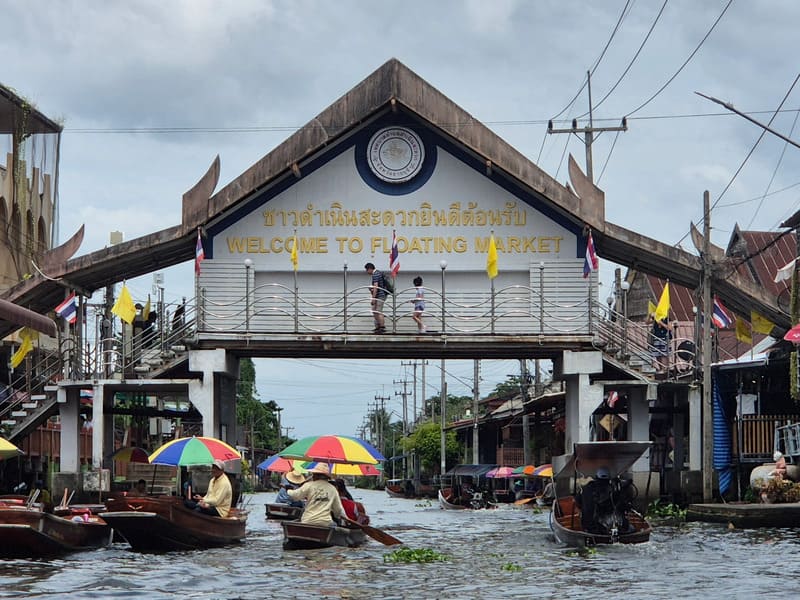
You can also decide between a shared boat (cheaper) or a private one (more comfortable). Motorboats fit up to 6 people, while rowing boats take up to 5. Prices are around 2,000 baht (≈60 USD) for a 90-minute motorboat ride, and sometimes there is a 100-baht surcharge if you pay by card.
And here’s a fun detail: the canal is two-way. During peak hours, boats pile up and create real traffic jams on the water, just like Bangkok’s chaotic streets, but floating! 🚤
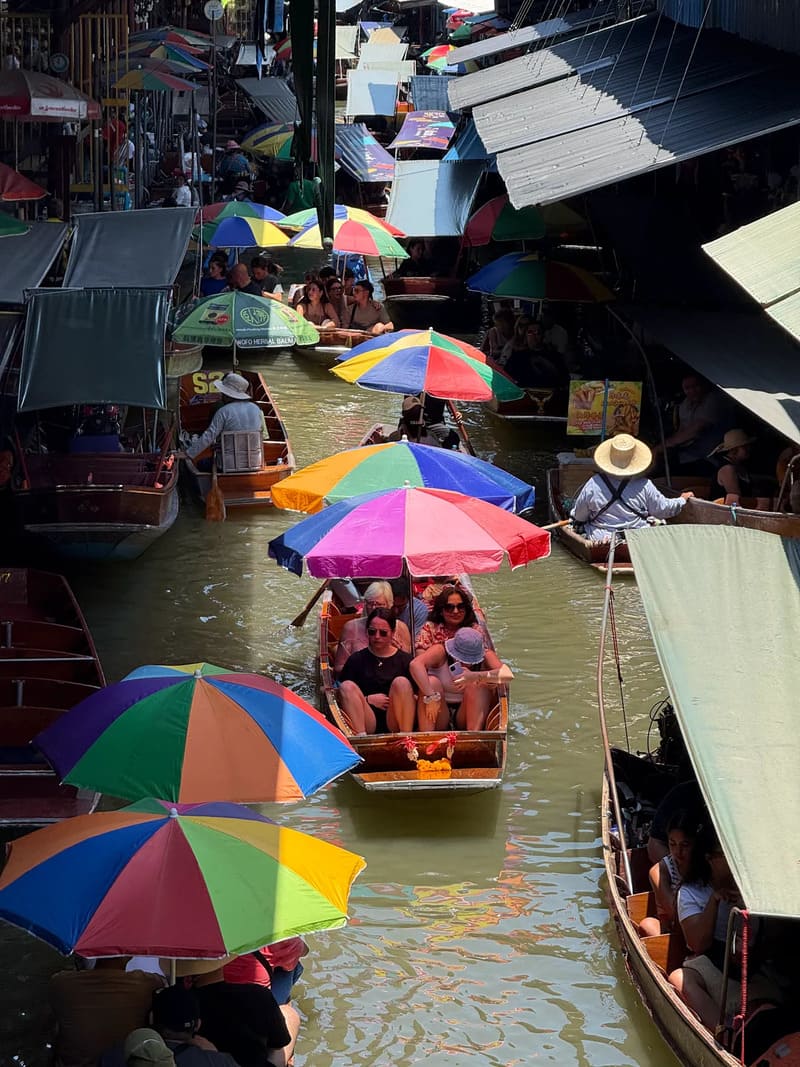
Stops during the boat trip
- The boat makes several stops so you can experience the market from different angles. Along the way, you’ll come across:
- Souvenirs: colorful paintings, folding fans, musical instruments, clothing (yes, including the famous elephant pants), small Buddha statues, carved elephants, traditional sarongs, spices, balsam oil, and herbal soap.
- Handicrafts: bamboo baskets, coconut-wood items, lacquered trays, silk scarves, paper lanterns, and traditional masks. At some stalls, artisans even demonstrate weaving or wood carving right on the spot.
- Experiences: sip fresh coconut, taste palm sugar, or pause for photos in the middle of the market’s vibrant energy. Sometimes vendors also offer souvenir photos taken at the start of your tour (around 300 baht).
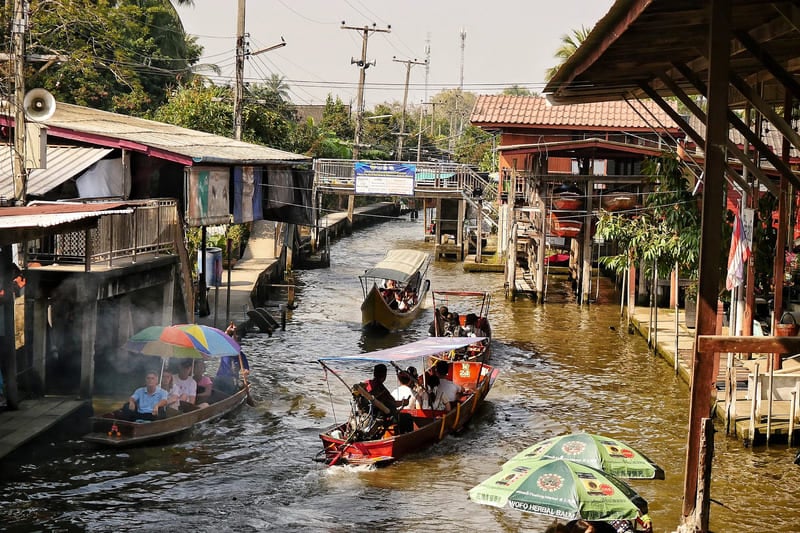
Practical Tips for Visiting Damnoen Saduak Floating Market
- Note your boat: Write down the number or name of your boat so you don’t get confused after a stop.
- Bargain smart: Prices are often higher than in other markets. Take your time, compare, and haggle; it’s common and you can often cut the price by half.
- Bring small change: Toilets at the market require a small fee, so keep some coins handy.
- Use cash: Credit cards are generally not accepted, so cash is the safest option.
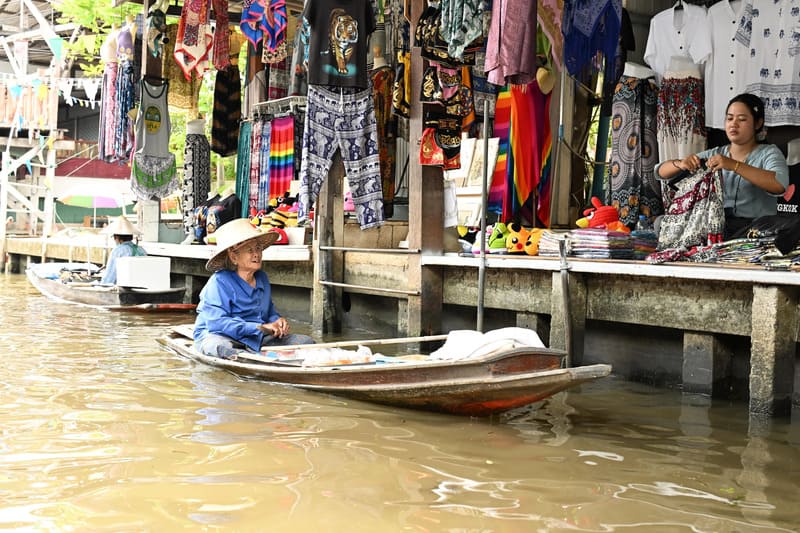
Gastronomy: an unmissable experience at the floating market
One of the best things to do at Damnoen Saduak Floating Market is to taste the dishes cooked right on the boats. The smells, the sizzling pans, and the colors all add to the experience. Here are some specialties you shouldn’t miss:
- Pad Thai: stir-fried noodles with shrimp or chicken, prepared right in front of you.
- Tom Yum: a hot and sour soup with lemongrass, galangal, and fresh chili.
- Som Tam (green papaya salad): crunchy, spicy, and refreshing, a true Thai classic.
- Mango Sticky Rice: sweet coconut rice paired with perfectly ripe mango.
- Coconut ice cream: served in a coconut shell, often topped with peanuts or corn.
- Tropical fruits: from pineapples and mangoes to juicy mangosteens, always a hit with visitors.
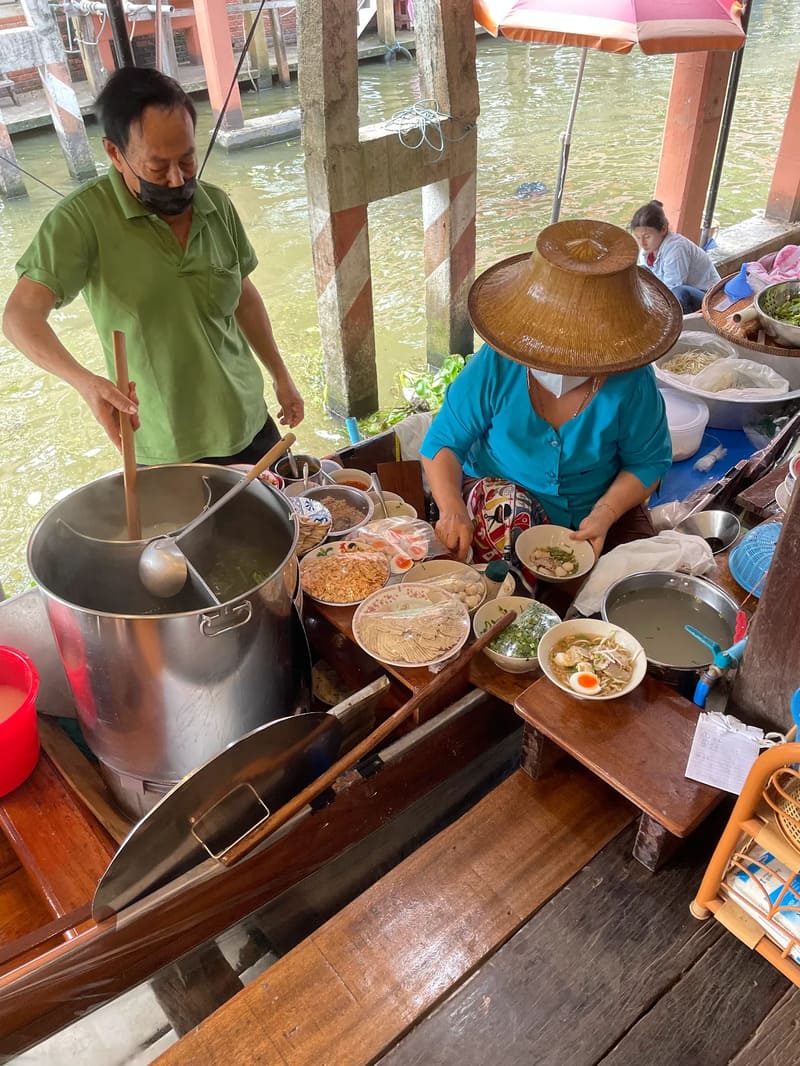
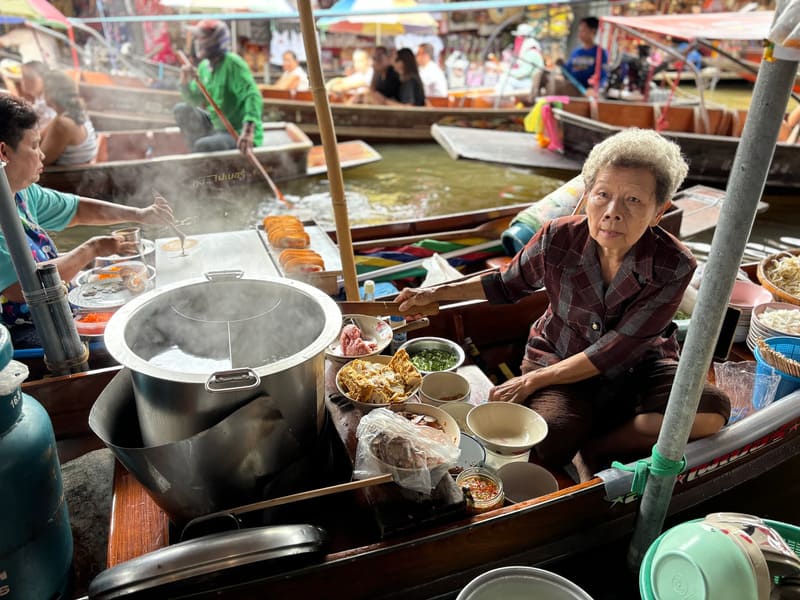
>>> 💡 Pro tip: choose the boats where locals or long queues gather; it’s usually the best sign of quality.
Damnoen Saduak Floating Market Reviews: Pros and Cons
From countless reviews on Reddit, Facebook groups, and my own visit, I can say Damnoen Saduak still keeps its authentic Thai charm. Here are the highlights you shouldn’t miss:
- Cruise the canals: ride through palm-lined waterways and watch daily life unfold on the water.
- Taste the flavors: try Pad Thai cooked on boats, fresh coconut ice cream, or tropical fruits like mangoes and mangosteens.
- Shop for souvenirs: browse stalls filled with crafts, bamboo baskets, silk scarves, and colorful trinkets.
- Step into history: explore more than 200 years of tradition at Thailand’s most famous floating market.
- Feel the atmosphere: enjoy the lively scene of dozens of boats packed with goods, vendors calling out, and the water buzzing with energy.
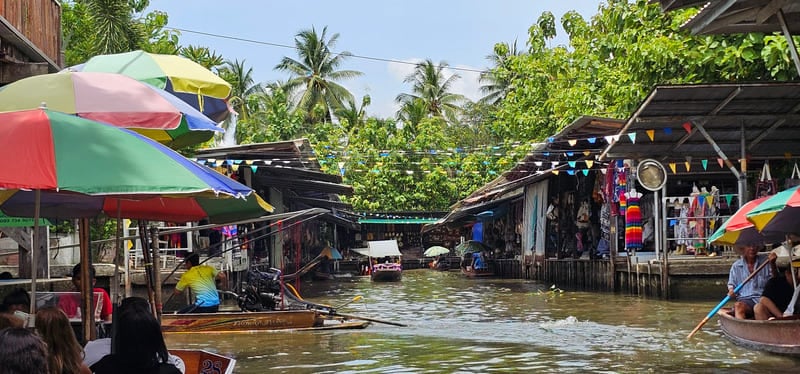
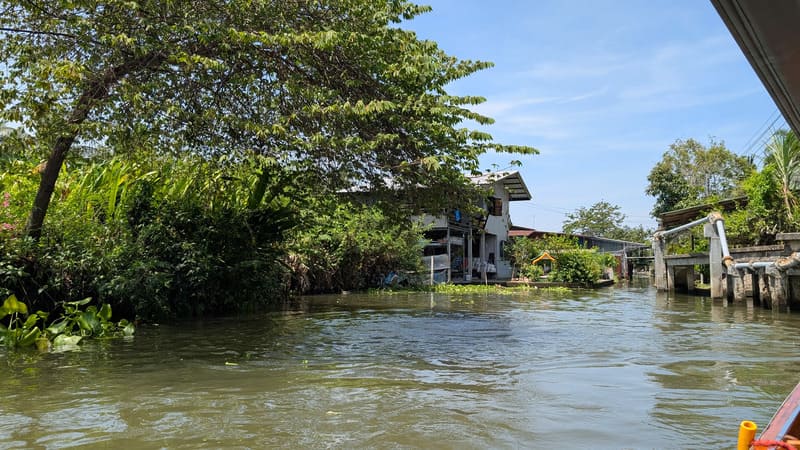
Negatives
The market does have a few downsides you should know about:
- You’ll find far more souvenir boats than food boats; sometimes ten times more.
- Food prices are higher than what you’d pay in the city.
- Boat routes often steer toward souvenir shops, so it can feel a bit guided rather than free.
- Weekends get very crowded, and some parts feel heavily commercialized.
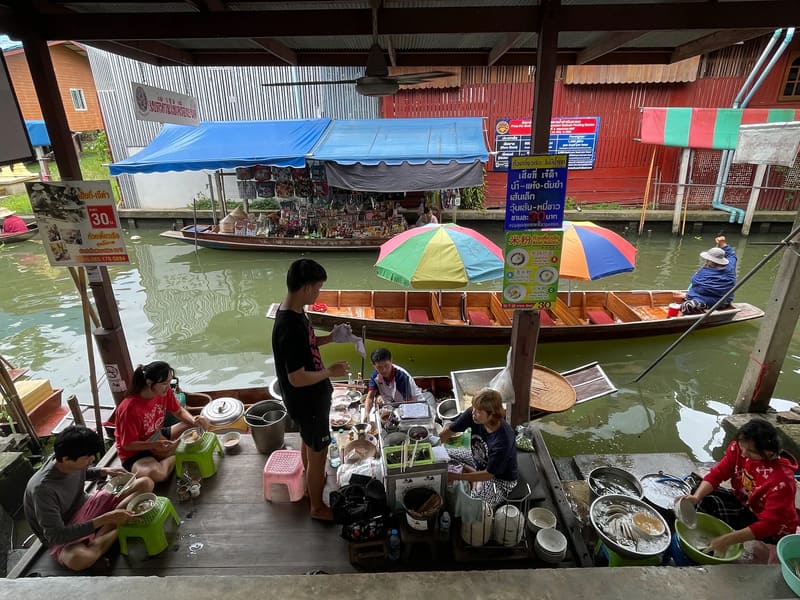
I point these out to give you a full picture. Honestly, I still enjoyed my visit because the market keeps a very “Thai” identity. If you’ve already explored several floating markets in Southeast Asia, this one may not surprise you. But for travelers coming from far away, especially Europe, and experiencing a floating market for the first time, Damnoen Saduak still feels original and memorable. Just keep the points above in mind, and your visit will go smoothly.
Quieter alternatives around Bangkok
If you want a quieter atmosphere and a glimpse of local life, these floating markets are great alternatives to Damnoen Saduak:
- Amphawa Floating Market: open in the late afternoon and evening, famous for freshly grilled seafood. As the sun sets, the market lights up with a magical glow along the river.
- Taling Chan Floating Market: only 12 km from central Bangkok. It’s small but friendly, filled with local dishes, and mostly visited by Thais rather than tourists.
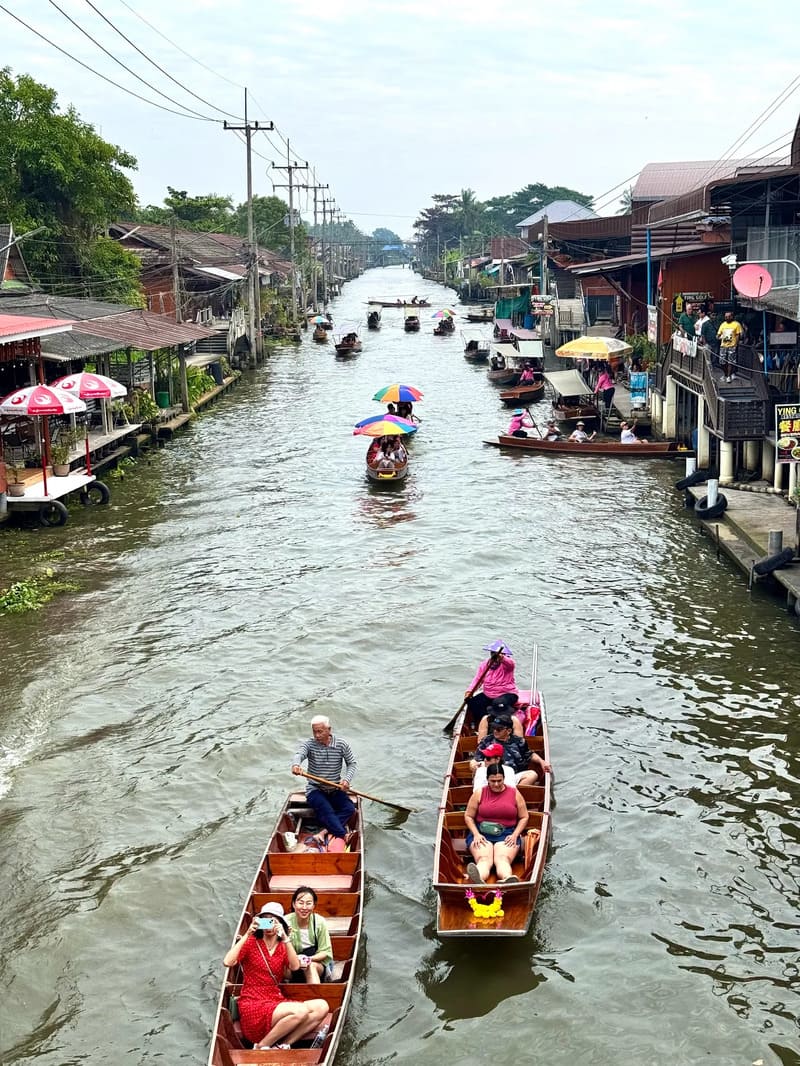
Our last words
In short, Damnoen Saduak left me with a mix of impressions. It may feel touristy in parts, but it’s still a colorful, lively market full of flavors and glimpses of local life. I hope my experience helps you plan your own visit and enjoy it to the fullest.
If you have any questions or want more tips, drop a comment below; I’ll be glad to help. Wishing you a fun and memorable visit to one of Thailand’s most iconic floating markets!
📌 Related articles:
- The 10 museums in Bangkok to visit to enrich your trip
- Discover Bangkok's Night Life – The Ultimate Guide for Night Owls
- What to Do in Bangkok, Thailand: 12 Unique Experiences You Can't Miss!
- A Local's Guide to Bangkok's Must-Visit Cafes
- Metro in Bangkok Thailand: Complete Guide to BTS and MRT
- Best Dinner Cruise in Bangkok 2025
- Top 9 Best Places to Stay in Bangkok
- Top 20 Best Restaurants in Bangkok












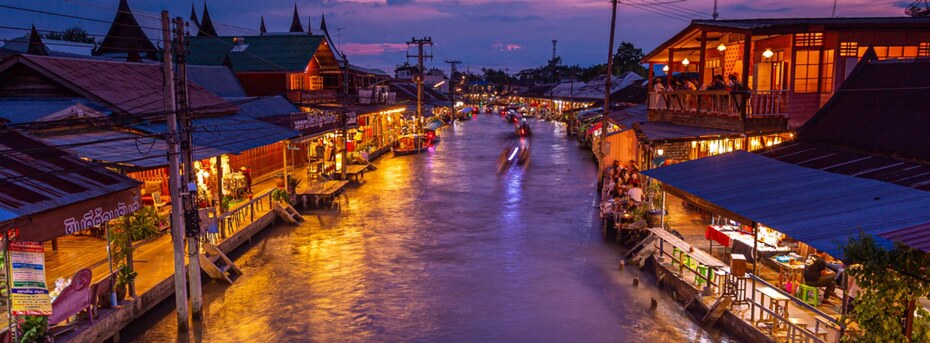

.jpg)
